Blogging Sax Rohmer’s The Mask of Fu Manchu – Part Four
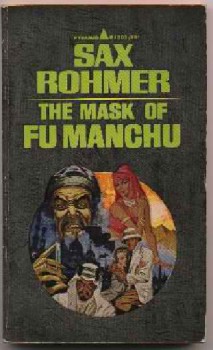
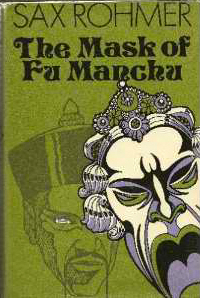 Sax Rohmer’s The Mask of Fu Manchu was originally serialized in Collier’s from May 7 to July 23, 1932. It was published in book form later that year by Doubleday in the US and the following year by Cassell in the UK. It became the most successful book in the series thanks to MGM’s cult classic film version starring Boris Karloff and Myrna Loy that made it into theaters later that same year.
Sax Rohmer’s The Mask of Fu Manchu was originally serialized in Collier’s from May 7 to July 23, 1932. It was published in book form later that year by Doubleday in the US and the following year by Cassell in the UK. It became the most successful book in the series thanks to MGM’s cult classic film version starring Boris Karloff and Myrna Loy that made it into theaters later that same year.
The fourth and final part of the book opens with the voyage from Cairo to London. The Marconi operator brings Shan Greville a telegram from Sir Denis Nayland Smith of British Intelligence, warning him that agents of Dr. Fu Manchu will attempt to capture the relics of El Mokanna that Sir Lionel Barton unearthed during his recent expedition in Persia. The irascible parliamentary minister who argued with Sir Lionel before boarding the ship turns out to be the agent of the Si-Fan who breaks into the purser’s safe overnight and absconds with the box he believes contains the priceless relics. He is rescued at sea by a plane which takes him and the contents of the box (concealed inside an inflatable rubber ball) aboard and disappears into the night.
This is a curious development on Rohmer’s part for while he is to be applauded for casting an Englishman as the villainous agent rather than an Asian, Greek, or Egyptian, the choice of disguise is a ridiculous one. Sir Denis quickly determines that there is no such parliamentary minister after cross-checking the passenger list. He wires Greville to have the man arrested as a spy. Greville inexplicably decides to ignore these instructions until morning, thus allowing the theft to occur.
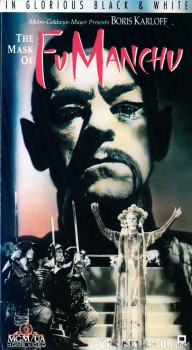
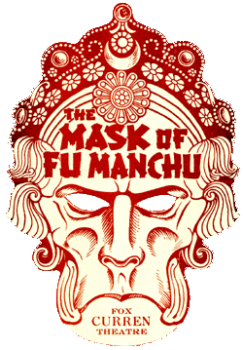 Rohmer had already telegraphed to the reader that the box in the purser’s safe was a decoy and the true relics were hidden in plain sight in Greville’s cabin, thus robbing the entire episode of all drama. Regrettably, Rohmer had painted himself into a corner. There was no other character to unmask than the MP if he was to advance the plot quickly enough. He had previously shown Sir Lionel trick Fu Manchu’s agents with decoys earlier in the story. Two such deceptions would clearly try readers’ patience and so Rohmer was forced to cut corners, resulting in a sloppy resolution to what should have been a suspenseful passage. As it stands, it is a rare flaw that is found late in an otherwise excellent story.
Rohmer had already telegraphed to the reader that the box in the purser’s safe was a decoy and the true relics were hidden in plain sight in Greville’s cabin, thus robbing the entire episode of all drama. Regrettably, Rohmer had painted himself into a corner. There was no other character to unmask than the MP if he was to advance the plot quickly enough. He had previously shown Sir Lionel trick Fu Manchu’s agents with decoys earlier in the story. Two such deceptions would clearly try readers’ patience and so Rohmer was forced to cut corners, resulting in a sloppy resolution to what should have been a suspenseful passage. As it stands, it is a rare flaw that is found late in an otherwise excellent story.
Once safely back in London, the relics of the Masked Prophet are safely stored away in a museum, awaiting Sir Lionel’s presentation before the Royal Society. Shan reads in The Times that the new Imam claiming to be the reincarnation of El Mokanna has been unmasked as a charlatan following Fu Manchu’s failure to produce the true relics before the gathering of dervishes in Damascus. Rohmer seems to have realized that this was the story’s true climax and the reader is unavoidably disappointed to learn that the unrest that gripped the Middle East has simply dissipated thanks to Sir Lionel having tricked Dr. Fu Manchu. From this perspective, it is understandable why MGM’s writing team chose to restructure the storyline to make this incident’s corollary the film’s climax. Of course, changing El Mokanna to Genghis Khan in the name of political correctness and then turning blatantly racist in having a deranged Nayland Smith turn Fu Manchu’s death ray on every Arab, African, and Chinese person in range were hardly points in favor of MGM’s adaptation.
Rohmer regains some momentum when he has Greville walking back to the hotel from the museum when he hears a familiar voice call to him from an abandoned home. In the tried and true fashion that Rohmer’s narrators are famous for, he stupidly investigates and is quickly overcome in the dark. Greville is aware that the speaker is Fah lo Suee, the seductive daughter of Fu Manchu, just before he is rendered unconscious. He recovers to find a constable investigating why he had entered an abandoned house. Shan, and the reader, begin to suspect the entire incident was a dream until he returns to his hotel room and discovers Fah lo Suee and her father awaiting his arrival.
What follows is a protracted sequence of drug-induced delirium. Greville’s exchange with Fu Manchu has a dreamlike quality and gives way to several episodes of his making passionate love with Fah lo Suee, first in his hotel room and then on the banks of the Nile. These sequences are far from explicit, but Rohmer has Shan drift in and out of delirium which only serves to heighten the sexual suggestion. He begins to recover his senses as Fah lo Suee tells him she must drive him back to his hotel in Cairo and that their lovemaking was the stuff of dreams, but once he awakens he will hate her. He pleads with her not to leave him and swears that he could never hate her and only craves her love. Suddenly Greville awakens in his hotel in London and is convinced the entire episode was a strange dream and nothing more.
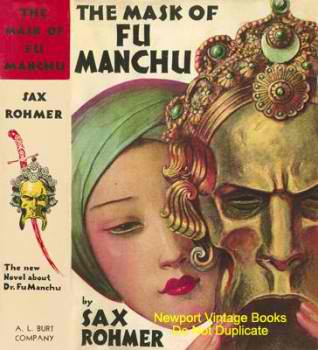
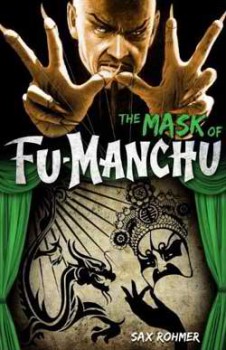 The following morning, he meets Sir Lionel at the museum to present the relics of El Mokanna before the Royal Society. The gathered dignitaries are incensed to discover that the relics are the decoys that Sir Lionel had made in Damascus. Greville realizes that his dream was reality. He was drugged when overcome in the abandoned house and under the influence, he let Fu Manchu and his daughter into the museum where they substituted the decoys for the true relics. Sir Lionel is surprisingly calm and accepting that Fu Manchu has bested him at last. The photographs of the real relics taken by his niece Rima as the expedition’s photographer are the only proof he has of his discovery. Fu Manchu may have been defeated in his ambition to unite the Middle East under the Si-Fan, but the relics of the False Prophet have been returned to their resting place in Ispahan.
The following morning, he meets Sir Lionel at the museum to present the relics of El Mokanna before the Royal Society. The gathered dignitaries are incensed to discover that the relics are the decoys that Sir Lionel had made in Damascus. Greville realizes that his dream was reality. He was drugged when overcome in the abandoned house and under the influence, he let Fu Manchu and his daughter into the museum where they substituted the decoys for the true relics. Sir Lionel is surprisingly calm and accepting that Fu Manchu has bested him at last. The photographs of the real relics taken by his niece Rima as the expedition’s photographer are the only proof he has of his discovery. Fu Manchu may have been defeated in his ambition to unite the Middle East under the Si-Fan, but the relics of the False Prophet have been returned to their resting place in Ispahan.
The novel then quickly proceeds to the long-delayed wedding of Shan and Rima at Sir Lionel’s estate. Shan expresses some pangs of guilt over his infidelity with Fah lo Suee, but knows that it is a weakness he could do nothing to resist. The incident reads a bit like Rohmer choosing to give his narrator one last fling before settling down, although Shan expresses some anxiety over what would happen should he encounter Fah lo Suee after his marriage. Rima, of course, remains unaware of his having strayed although she resents Fah lo Suee for being an obvious sexual predator with a strong interest in Shan.
Rather late in the proceedings, a comic relief character is introduced in the form of Sir Lionel’s previously unmentioned younger sister, Lady Ettrington. Sir Lionel’s sister is a hopeless snob upset that Rima is marrying beneath her class. There is the slightest suggestion that her objection might be more than socially and financially motivated, given Greville’s background as a half-caste, but sadly Rohmer nevers does more than hint at this.
Considering that he peopled his works with Eurasians and that Kara Petrie, consistently described as the most beautiful woman in the world, is herself a mix of Egyptian and European, it would have been fitting had he developed this dimension further. Sadly, Shan is unique in that he is the male protagonist and narrator and must consequently adhere to the code and do nothing to violate reader identification. Having his narrator / protagonist fall in love with a beautiful and seductive half-caste was acceptable to readers of the time for the romance of the exotic foreign otherness was something readers could safely relish from afar; but asking them to step into the shoes of a half-caste was too much for a colonial mindset, or so an Edwardian like Rohmer would conclude.
Shan and Rima’s wedding comes off perfectly once Sir Lionel puts Lady Ettrington in her place. The unexpected finale is their discovery that Dr. Fu Manchu has personally delivered a wedding present for the bride and groom. He leaves behind an eloquent letter wishing them much happiness and insuring them they have no need to fear any reprisal. Rima’s presents are a necklace of one-hundred perfectly matched pink pearls and a casket belonging to Catherine of Russia bedecked with eighty flawless diamonds. Shan’s presents are an ebony box belonging to King Solomon and the signet ring of the Egyptian Pharaoh Khufu.
Rohmer had revitalized Dr. Fu Manchu but with the fifth book in the series published on the twentieth anniversary of the character’s first appearance, Rohmer was content to let Fu Manchu, Nayland Smith, and the rest of his cast of characters retire peacefully…until the next book. Eighty years after The Mask of Fu Manchu was a bestseller and box office success and one-hundred years after the Devil Doctor first appeared in “The Zayat Kiss,” it is an honor to continue his exploits for Sax Rohmer’s Literary Estate and look back on the classic original series (currently being reprinted through the efforts of Titan Books). Sir Christopher Lee and Harry Alan Towers were correct all those years ago, where Dr. Fu Manchu is concerned, the world is always fated to hear from him again.
William Patrick Maynard was authorized to continue Sax Rohmer’s Fu Manchu thrillers beginning with The Terror of Fu Manchu (2009; Black Coat Press). A sequel, The Destiny of Fu Manchu was published earlier this year by Black Coat Press. Next up is a collection of short stories featuring an Edwardian detective, The Occult Case Book of Shankar Hardwicke and a hardboiled detective novel, Lawhead. To see additional articles by William, visit his blog at SetiSays.blogspot.com